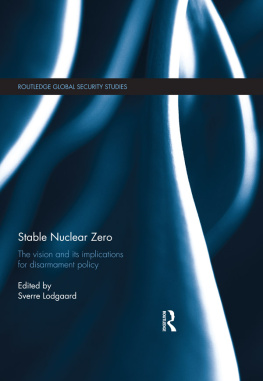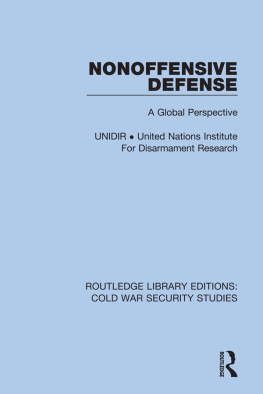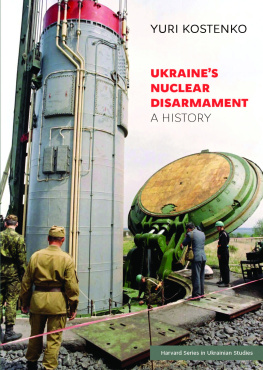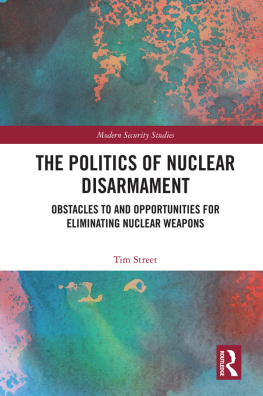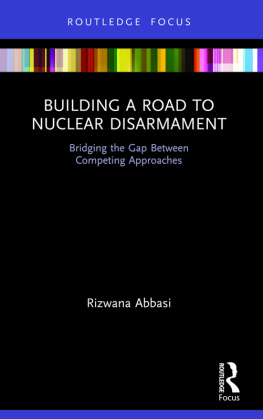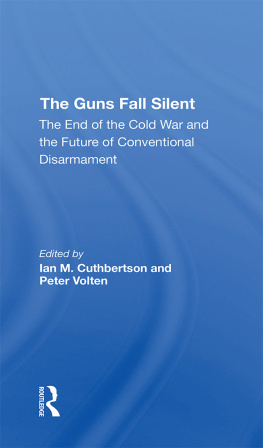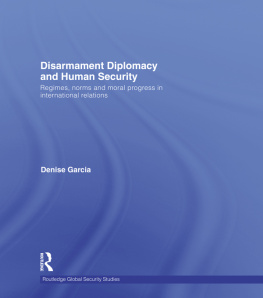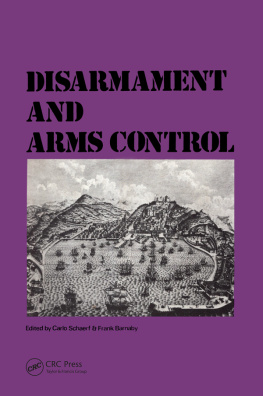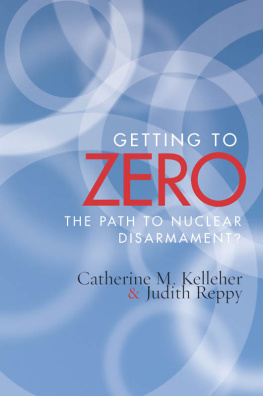First published in 1989 by Taylor & Francis Ltd
This edition first published in 2021
by Routledge
2 Park Square, Milton Park, Abingdon, Oxon OX14 4RN
and by Routledge
52 Vanderbilt Avenue, New York, NY 10017
Routledge is an imprint of the Taylor & Francis Group, an informa business
1989 United Nations Institute for Disarmament Research
All rights reserved. No part of this book may be reprinted or reproduced or utilised in any form or by any electronic, mechanical, or other means, now known or hereafter invented, including photocopying and recording, or in any information storage or retrieval system, without permission in writing from the publishers.
Trademark notice: Product or corporate names may be trademarks or registered trademarks, and are used only for identification and explanation without intent to infringe.
British Library Cataloguing in Publication Data
A catalogue record for this book is available from the British Library
ISBN: 978-0-367-56630-2 (Set)
ISBN: 978-1-00-312438-2 (Set) (ebk)
ISBN: 978-0-367-62782-9 (Volume 38) (hbk)
ISBN: 978-1-00-311079-8 (Volume 38) (ebk)
Publishers Note
The publisher has gone to great lengths to ensure the quality of this reprint but points out that some imperfections in the original copies may be apparent.
Disclaimer
The publisher has made every effort to trace copyright holders and would welcome correspondence from those they have been unable to trace.
| USA | Publishing Office: | Taylor & Francis New York Inc.
79 Madison Avenue, New York, NY 10016-7892 |
| Sales Office: | Taylor & Francis Inc.
1900 Frost Road, Bristol, PA 19007 |
| UK | Taylor & Francis Ltd.
4 John Street, London WC1N 2ET |
Problems and Perspectives of Conventional Disarmament in Europe
Copyright 1989 United Nations Institute for Disarmament Research
All rights reserved. No part of this publication may be reproduced, stored in a retrieval system, or transmitted, in any form or by any means, electronic, electrostatic, magnetic tape, mechanical, photocopying, recording or otherwise, without the prior permission of the copyright owner.
First published 1989
Printed in the United States of America
Library of Congress Cataloging in Publication Data
Problems and perspectives of conventional disarmament in Europe.
1. DisarmamentCongresses. 2. EuropeMilitary relationsCongresses. I. United
Nations Institute for Disarmament Research.
JX1974.P684 1989 337.174094 89-20421
ISBN 0-8448-1652-3
Contents
Chapter 1. Reduction of Conventional Forces in EuropeProblems and Perspectives
Victor Karpov
Chapter 2. Factual Groundwork
Arne Olav Brundtland
Chapter 3. Responses
First Response
William Hopkinson
Second Response
Manfred Mller
Third Response
Thodore Winkler
Part II: Problems of Comparison between Different Conventional Armament Systems
Chapter 4. Problems and Perspectives of Conventional Disarmament
Jon Gundersen
Chapter 5. Problems of Comparison
Gyula Horn
Chapter 6. Responses
First Response
Joachim Krause
Second Response
Kari Mttl
Third Response
Hans-Peter Neuhold
Part III: Objectives and Methods of Reduction, Limitation, and Stabilization
Chapter 7. Limitation and Reduction of Conventional Arms: Objectives and Methods
Nikolai Chervov
Chapter 8. Future Negotiations on Conventional Stability
Jerome Paolini
Chapter 9. Responses
First Response
Benoit dAboville
Second Response
Rolf Ekus
Third Response
John van Oudenaren
Fourth Response
Zdenk Pag
Part IV: Confidence-Building Measures and Verification
Chapter 10. CSBMs in Europe: A Future-Oriented Concept
Adam-Daniel Rotfeld
Chapter 11. Verification of Confidence- and Security-Building Measures
Joseph Schrli
Chapter 12. Responses
First Response
Jean Desazars de Montgailhard
Second Response
Ignac Golob
Third Response
Roger J. Hill
Fourth Response
Victor-Yves Ghebali
Part V: Conventional Disarmament in Europe and Its Impact on the Rest of the World
Chapter 13. The Prospect of Conventional Disarmament
Oluyemi Adeniji
Chapter 14. Super Power Relations as a Key
Rikhi Jaipal
Chapter 15. Responses
First Response
Marcos Castrioto de Azambuja
Second Response
Fan Guoxiang
Third Response
Pierre Morel
Fourth Response
John Edwin Mroz
Fifth Response
Hennig Wegener
- Chapter 1. Reduction of Conventional Forces in EuropeProblems and Perspectives
- Chapter 2. Factual Groundwork
- Chapter 3. Responses
- First Response
- Second Response
- Third Response
- Part II: Problems of Comparison between Different Conventional Armament Systems
- Chapter 4. Problems and Perspectives of Conventional Disarmament
- Chapter 5. Problems of Comparison
- Chapter 6. Responses
- First Response
- Second Response
- Third Response
- Part III: Objectives and Methods of Reduction, Limitation, and Stabilization
- Chapter 7. Limitation and Reduction of Conventional Arms: Objectives and Methods
- Chapter 8. Future Negotiations on Conventional Stability
- Chapter 9. Responses
- First Response
- Second Response
- Third Response
- Fourth Response
- Part IV: Confidence-Building Measures and Verification
- Chapter 10. CSBMs in Europe: A Future-Oriented Concept
- Chapter 11. Verification of Confidence- and Security-Building Measures
- Chapter 12. Responses
- First Response
- Second Response
- Third Response
- Fourth Response
- Part V: Conventional Disarmament in Europe and Its Impact on the Rest of the World
- Chapter 13. The Prospect of Conventional Disarmament
- Chapter 14. Super Power Relations as a Key
- Chapter 15. Responses
- First Response
- Second Response
- Third Response
- Fourth Response
- Fifth Response
Guide
In paragraphs 81 and 82 of the Final Document of the Tenth Special Session of the General Assembly, the most comprehensive consensus statement on disarmament formulated to date by the international communitythe provisions of which, according to the statute of UNIDIR forms the basis of its workit was considered that Together with the negotiations on nuclear disarmament measures, the limitation and gradual reduction of armed forces and conventional weapons should be resolutely pursued within the framework of progress towards general and complete disarmament. States with larger military arsenals were especially urged to pursue endeavors and Europe was specifically singled out as a priority region of the globe where agreement on mutual reductions and limitations of military potential could greatly contribute to the enhancement of international peace and security.


